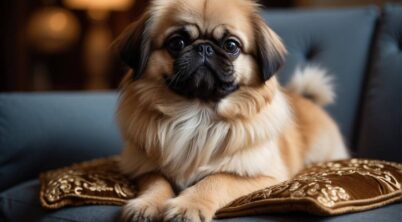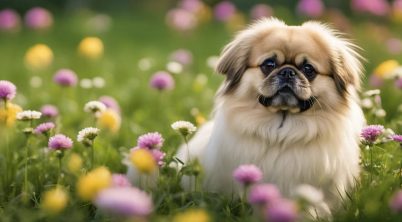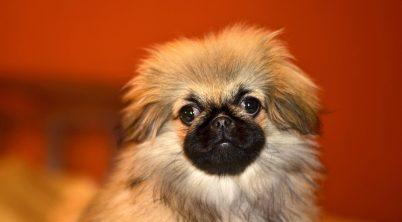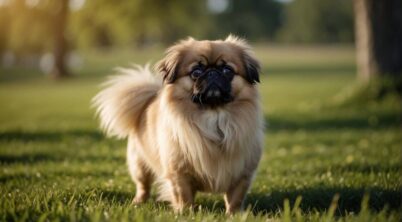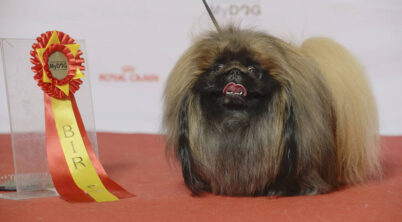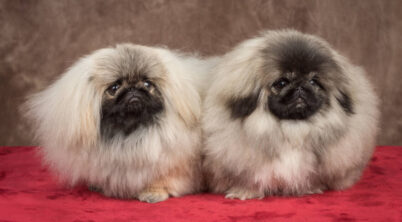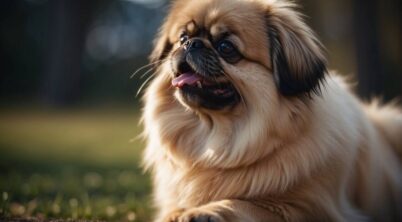The Pekingese is a distinguished toy breed originating from ancient China, where they were held in great esteem by Chinese royalty. This breed is easily recognizable by its luxurious coat that comes in colors including tan, red, black, white, gold, sable, and cream. Their tails are a defining feature, set high and adorned with an abundance of fur that arcs gracefully over their back, accentuating the breed’s unique silhouette. In keeping with the breed’s royal lineage, a proper Pekingese tail is free of kinks and curls, forming a harmonious line with the rest of the body.
These dogs carry their tail proudly, which contributes to their overall regal appearance. Any deviation from the breed’s standard, such as tails with excessive curling, is typically considered a serious fault and could warrant attention from a veterinarian. The Pekingese’s small stature belies a confident and self-possessed character, and while their appearance is one of their most cherished attributes, it’s their tail that often leaves a lasting impression.
Bearing the history of a breed that served as companions to nobility, the Pekingese’s tail is not just a feature of physical aesthetics but also a marker of its aristocratic past. As the breed has evolved, the standards for its tail and overall presentation have remained a symbol of its heritage—a heritage that once graced the palaces and gardens of imperial China. The Pekingese presents an air of elegance, with its tail being one small yet significant part of the breed’s storied tradition and enduring appeal.
Pekingese Tail
The tail of a Pekingese is set high on its back, a feature that complements its noble profile.
Characteristics of the Tail:
- Position: The tail is carried regally over the back forming a slight arch, which is both a breed standard and a part of its majestic appeal.
- Structure: A desired trait for the tail is to lack kinks or curls that deviate from the standard, which usually signals an essential evaluation by a veterinarian.
The Pekingese was also known as a “lion dog” due to its resemblance to Chinese guardian lion statues, and its tail contributes to this lion-like appearance. Moreover, these dogs were sometimes referred to as “sleeve dogs” because members of the royalty would carry them in the voluminous sleeves of their robes, an act that was facilitated in part by their compact size and their flowing tail.
Holding a status of being both “pure” and “sacred,” the Pekingese breed was venerated in old Buddhist tales that link them spiritually to the religion’s deities. Legend has it that the breed could only be owned by members of the imperial palace, and their unique tail was one of the breed’s attributes that made it fit for nobility.
When British troops invaded the Forbidden City during the Second Opium War, they found these imperial dogs and brought them to the West where they eventually caught the eye of Queen Victoria, adding to their renown and perpetuating their status as dogs of distinction.
The Pekingese’s tail is not only an important aspect of the breed’s standard but also a symbol of its regal heritage and standing as a dog of luxury and sacredness throughout history.
Potential Tail Issues
The Pekingese breed, recognized for its dignified demeanor, is also identified by its characteristic tail. The tail, carried proudly over the back with a plume of fur, can encounter several potential health issues.
- Kinks and Curls: While a slight arch is breed-standard, deviations such as kinks or curls can arise. These are not just cosmetic concerns; they may signal underlying skeletal problems. A veterinarian should assess these irregularities to ensure they do not impact the dog’s well-being.
- Fragility: Due to breed standards that favor a certain tail structure, Pekingese tails may be subject to fragility. Extra care during grooming and handling is essential. The Pekingese may exhibit signs of discomfort or anxiety if their tail is handled improperly or if they experience tail trauma.
Regarding general health issues related to their brachycephalic nature, Pekingese can be prone to complications due to their short snout, which can lead to heavy breathing and exercise intolerance. Owners must monitor their Pekingese during physical activity to prevent respiratory distress, keeping in mind that these factors can indirectly affect tail health.
In conclusion, Pekingese owners should regularly inspect their dog’s tail for any abnormalities, maintain gentle handling practices, and seek veterinary advice when potential issues are observed. Proper care and attention to tail health are integral in preserving the overall health and dignity of the breed.
Grooming and Care
Caring for a Pekingese’s tail involves meticulous grooming techniques to maintain its distinctive plumed appearance. Regular grooming is not just about aesthetics; it also supports the overall health and comfort of the dog. Here is a structured approach to maintaining the Pekingese’s tail coat:
Daily Brushing
Brushing the tail daily with a pin brush or slicker is crucial to remove tangles and prevent mats from forming. Given their double coat, attention to the undercoat is necessary to remove loose fur and maintain cleanliness. This daily routine also serves to inspect the tail area for any signs of irritation or infection.
Bathing and Drying
During a bath, ensure gentle cleaning of the tail, avoiding harsh chemicals that can dry out the coat or irritate the skin. Drying is equally important; moisture trapped in the heavy coat can lead to skin issues. Always dry thoroughly, ideally with a blow dryer set on a cool to medium temperature.
Trimming
Regular trimming is an aspect of grooming that protects the Pekingese’s tail from collecting debris. Trimming excess hair will prevent fecal matter from adhering to the fur, a common problem due to their low build and stocky shape. Care should be taken to maintain the natural contour of the tail’s plume.
General Tips
When grooming:
- Use gentle strokes to avoid causing discomfort, especially since Pekingese can have sensitive skin beneath their heavy coat.
- Never rush the grooming process; patience ensures thorough care and minimizes stress for the dog.
By exercising these grooming practices, Pekingeses’ tails can remain in top condition, reflective of their proud and strong character. Grooming also reinforces the bond between the pet and owner, contributing to the Pekingese’s well-being and satisfaction as a watchdog and companion.

